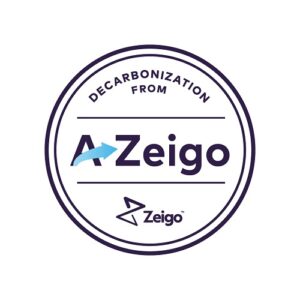…and how does net-zero regulation impact small and medium-sized enterprises?
The United Nations set a goal to cut carbon emissions in half by 2030 and achieve “net-zero” by 2050. It may feel like these dates are eons away but they will come sooner than we think. It will take a formidable effort up and down the supply chain to achieve net-zero. But what do you do if you’re not even sure what net-zero means, let alone how to start contributing to the effort? Consider this article your net-zero primer.
Key takeaways
- Learn to define net-zero and other key terms related to private sector climate change initiatives
- Get the basics about how large and small to medium enterprises (SMEs) work together to reduce their carbon footprints
- If you’re an SME, gain tips to start reducing your organization’s greenhouse gasses
What does “net-zero” mean?
Net-zero, in the most simple terms, is a math equation to calculate a company’s emissions, or climate footprint. Organizations can reach net-zero with a combination of actions:
- Eliminating or reducing their own emissions
- Purchasing carbon offsets—or financially supporting someone else’s emissions reduction efforts
The terms “carbon-neutral” and “climate neutral” are also used to describe this decarbonization process. Typically, companies try to reduce their own emissions first, and use carbon offsets for those emissions that are hardest to reduce.
Let’s talk about emissions
You may hear the terms “carbon emissions” and “carbon footprint” used interchangeably with emissions and greenhouse gasses (GHG)s. Technically, GHGs include all emissions from fossil-fueled human activity—not just carbon emissions. Carbon dioxide (CO2), methane (CO4), nitrous oxide (N2O), and fluorinated gasses contribute to a total emissions footprint, but may get reported under a unified metric called the carbon dioxide equivalent (CO2e).
It’s safe to say that efforts to reduce emissions will include a hard look at a company’s fossil-fueled electricity consumption and burning transportation fuels. These common business practices contribute to global warming, and a shift toward sustainable fuel is critical to reach the global net-zero goals set by the United Nations.
Enterprises can’t reach net-zero goals without SMEs
It’s not just lofty climate change goals that motivate global corporations to reduce emissions. Decreasing their carbon footprint makes business sense. In addition to increased intergovernmental and domestic regulatory pressure many businesses have identified significant financial risk associated with climate change. That’s because climate change-related events have become increasingly disruptive to the supply chain. In fact, one analysis projected supply chain costs up to 120 billion USD due to environmental risks. It’s impossible to ignore the problem with so much at stake.
Furthermore, an estimated 70 percent of emissions originate in the supply chain, so it’s easy to foresee that pressure to reduce GHGs will move downstream. Enterprises can’t achieve their goals without enlisting partnership from the SMEs in their supply chain.
[Cross-post: Curious how SMEs can make an impact? Read our post, Small and Medium Enterprises are Critical to Net-Zero Goals.]
Decarbonization reporting requirements trickle down to SMEs
SMEs aren’t currently required to report Scope 3 emissions—the emissions that are represented up and downstream their supply chain. But publicly traded companies are required to report:
- Scope 1 emissions directly from sources they own or control
- Scope 2 emissions from energy they purchase
- Scope 3 emissions in their supply chain
As these large companies rely on SMEs to comprise the majority of their supply chain, SMEs gain a huge upside by proactively tracking and reporting their own emissions, even though they aren’t always required to. Doing so gives SMEs a competitive edge by facilitating easier emissions governance for their clients. Additionally, reports Forbes, net-zero collaboration between large organizations and SMEs are ripe with benefits; including increased investment and positive consumer perception.
How SMEs can get started on a path to net-zero
To capitalize on that benefit, SMEs must begin their own decarbonization journey—but how? We recommend a four-step process.
- Measure. First, we establish a baseline by guiding you through the process to calculate, measure, and analyze your organization’s carbon footprint.
- Plan. With a baseline established, we help you build a customized action roadmap based on targets that work for your business and strategy.
- Connect. Now it’s time to put that plan into action. Explore Zeigo Activate’s open marketplace to find energy and sustainability partners to help you achieve your goals.
- Report. Real, tangible results matter to your stakeholders. Use our easy-to-read dashboards to track progress, optimize your plan over time and share results with stakeholders.
Companies like Microsoft, Apple, and Amazon have made public sustainability commitments and need their supply chain to commit, too. Zeigo’s fully-digitized tools take the guesswork out of achieving net-zero goals.
There’s no way to reach net-zero without SMEs and there’s no better partner on your journey than Zeigo. Visit zeigo.com/activate to learn more or contact us to book a demo today.
